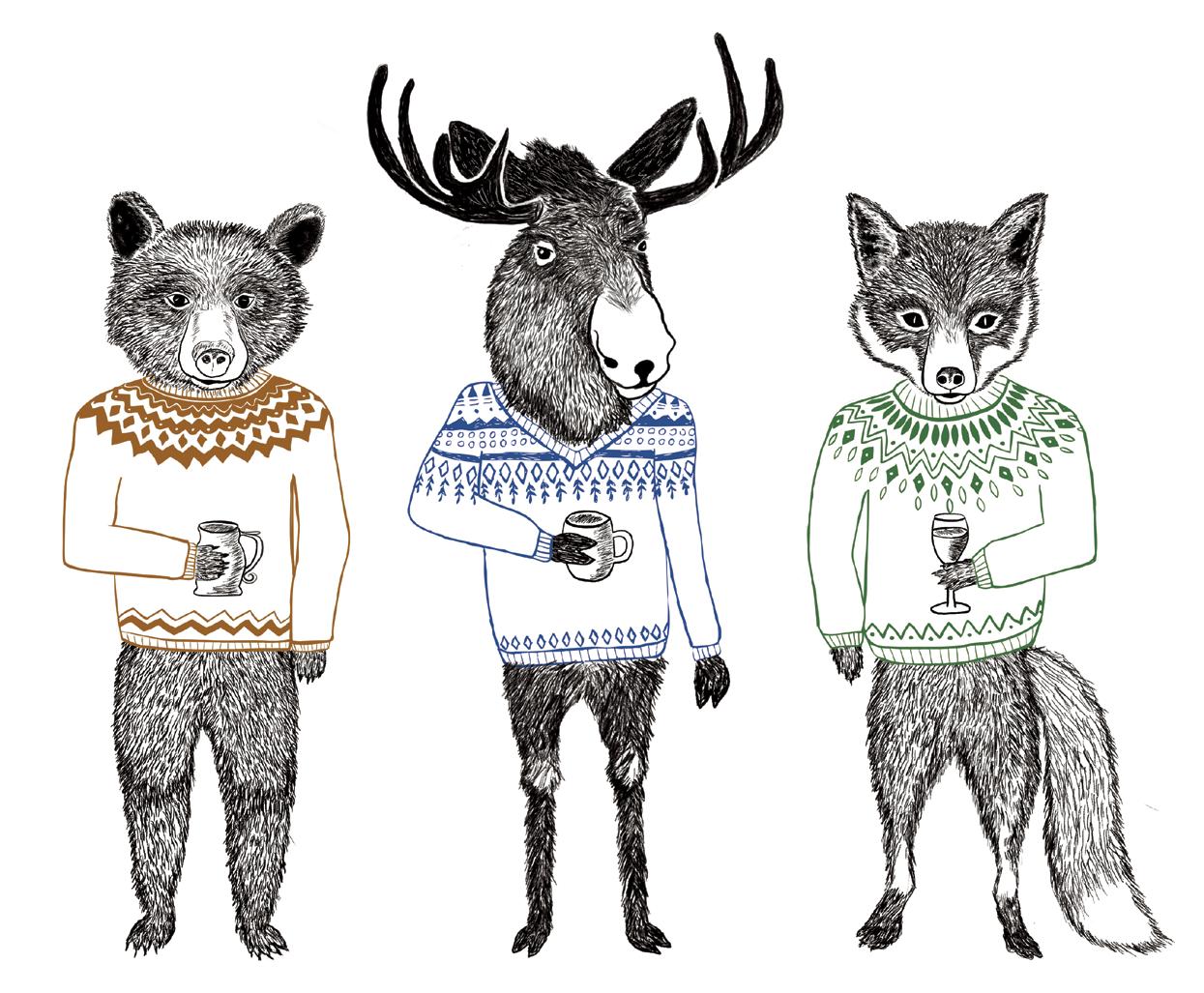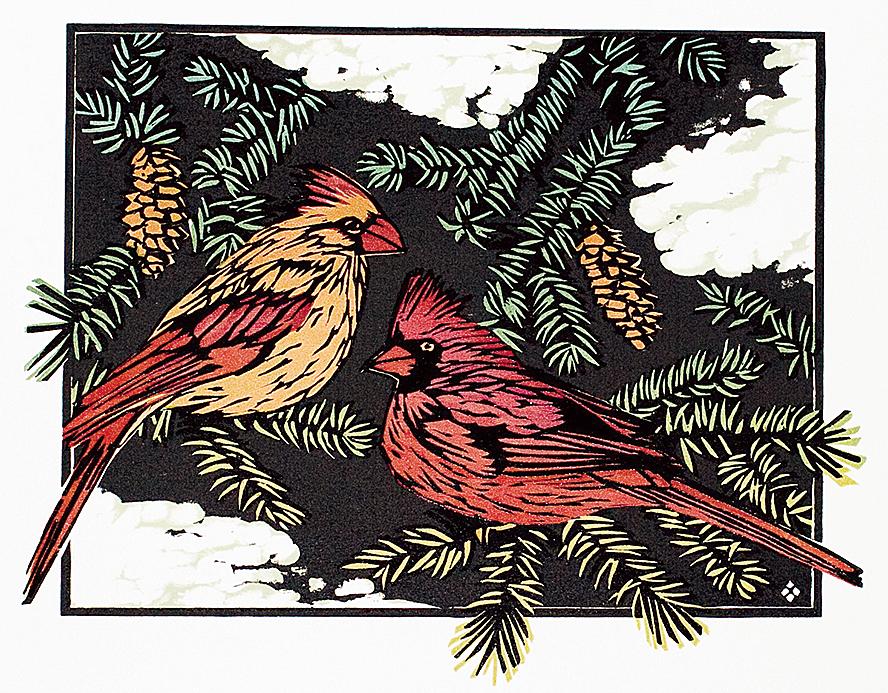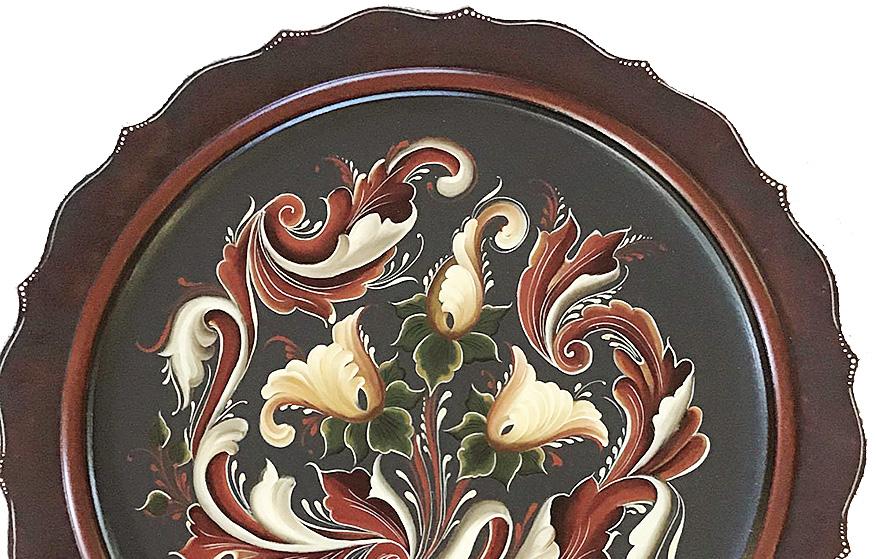
8 minute read
Spotlight
By Breana Roy
“Northern Animals Wearing Sweaters” by Duluth illustrator
Advertisement
and printmaker Carrie Schaefer. | CARRIE SCHAEFER
‘Tis the season It’s my favorite time of year; the festive decorations and sparkling lights, the time spent with loved ones laughing and playing games, eating way too much delicious food, and sipping hot chocolate or cider next to a crackling fireplace. Here’s some winter and holiday inspired artwork in honor of this magical season. Happy Holidays!
This oil painting by Sara Qualey is titled “Holiday Cheer.” Her work can be
found at Lizzards Art Gallery in Duluth. | SARA QUALEY

According to Lutsen artist Kari Vick, “there’s no better way to pass a winter’s eve than with the ones you love.” This painting is titled “Merry Me?”
| KARI VICK

“Reach for the Stars” by Aaron Kloss. His work can be found at numerous stores along the North Shore, including Sivertson Gallery in Grand Marais.
| AARON KLOSS
Duluth illustrator Jordan Sundberg created this piece, titled “Hello,
Dalaling.” | JORDAN SUNDBERG
“Cardinals” is a woodcut by Grand Marais artist Betsy Bowen. View more of her work at Holiday Art Underground. See the event section for more
info. | BETSY BOWEN



MARY SCHLIEP Traditional Norwegian Rosemaling CREATIVE SPACE: By Rae Poynter

Art is one of the most powerful ways of keeping heritage alive. While the modern world seems to evolve at an increasingly rapid pace, art has a staying power that connects us to the ways of the past and those who have gone before us. For Mary Schliep, the art of rosemaling is both a beautifying craft and a way to honor her Norwegian roots.
Schliep’s father Chris Tormondsen was an immigrant who left Norway at the age of 14 bound for Tofte. It was there that he built a life and where Mary Schliep grew up. Her interest in rosemaling began when her father came home one day with a Norwegian “Tina” box that was decorated with rosemaling. She was captivated by the design and in 1989 she began taking rosemaling classes once a week in Two Harbors.
Rosemaling, which means “flower painting” in Norwegian, dates back to the mid1700s. At the time, decorative painters from greater Europe came to Norway to decorate homes for wealthy merchants. In rural Norway, local residents began to imitate the work of the artists who visited the upper-class families, and distinctive styles of rosemaling began to emerge in each region. For example, Telemark rosemaling tends to feature asymmetrical scrolls, while the Hallingdal style features symmetrical designs, and Vest-Agder tends to feature tulips due to frequent trade with Holland. Rosemaling also became popular in rural Sweden. Eventually, immigrants like Schliep’s father brought their folk art with them when they came to the United States, and in places like Minnesota, where many Scandivanian immigrants settled, the tradition of rosemaling continues on.
After taking classes in Two Harbors and continuing to do rosemaling, Schliep headed where many serious rosemalers go: Vesterheim, The National Norwegian-American Museum and Heritage Center in Decorah, Iowa. It was there that she took classes from top instructors, including two instructors from Norway, and perfected her painting skills.
The most basic building blocks of rosemaling are C curves and S curves. From there, the scrollwork in rosemaling is made more intricate with detailed patterns and flowers. Rosemaling is often painted on furniture, bowls, platters, or other wood surfaces, sometimes with an accompanying quote.
“I mainly use oil paints for rosemaling,” Schliep said. “Sometimes I’ll use acrylics for other things like painting gnomes, but oils are better for rosemaling.”
When the North House Folk School opened in Grand Marais, Mark Hanson contacted Schliep about becoming a rosemaling instructor. She agreed, becoming one of North House’s earliest instructors, and has been teaching six classes a year on the Telemark and Valdres styles. Schliep says that rosemaling is quite popular, and her classes typically have waiting lists for interested learners.
In 1989, Mary Schliep began taking rosemaling classes once a week in Two Harbors. Now, she teaches six classes a year at the North House Folk School
on the Telemark and Valdres styles. | MARY SCHLIEP
In addition to rosemaling, Schliep also teaches Swedish Folk painting, or
“dalmalning.” | MARY SCHLIEP
Most of Schliep’s work comes from consignments. Through attending festivals, people from all over North America have come to know her work, and she gets orders from all over the U.S. and Canada. And in addition to rosemaling, Schliep also teaches Swedish folk painting, or “dalmalning,” which is often more personalized than rosemaling and used to tell stories.
While the current pandemic has put a pause on in-person classes, those who are interested in learning rosemaling for themselves have options online.
“There are so many resources out there today,” Schliep said. “Zoom classes are really interesting and fun to watch—some of them have a fee but some of them are free. North House will have some Zoom classes, and there’s a lot you can find online if you want to learn.”



Betsy Bowen Studio’s Holiday Art Underground 2020 November 27 - December 31
Fabulous fresh art from dozens of makers: fiber, glass, woodcuts, cards, books, paintings, pottery, tiles, and wooden ware. December Studio Hours: 11-5 Thursday through Sunday. Betsy Bowen Studio 301 First Avenue West Grand Marais ª 218-387-1992 woodcut.com for the webstore @betsybowen for Instagram and Facebook
FOCUS ON ARROWHEAD FIBER GUILDS Warm Up with Fiber Crafts
BEHIND THE CRAFT: By Carol Colburn
Winter means cold outside, but cozy inside with the warm embrace of fibers. It is a good time to immerse yourself in fiber in all its forms. Want to start a fiber craft but need inspiration, direction, or don’t know where to start? There are others in the same boat and many more who are willing to help. That is what the fiber guilds do best. In the Minnesota Arrowhead region, we have a number of strong organizations whose main mission is to share the joys of fiber crafts.
Knitting, crocheting, felting, spinning, weaving, rug braiding, quilting, sewing, dyeing—the list goes on of crafts that have fiber as their core material. Fibers of all sorts are used to create useful or decorative textiles that enhance our lives in many ways. The fiber community on the North Shore has an allure that stems from the immediate need to stay warm and busy in the cold weather, but also comes from the easy exchange of techniques among crafters, and the traditions of handing down craft in families and among friends.
With so many fiber techniques, where do new or curious fiber artisans find community? The North House Folk School in Grand Marais regularly teaches a long menu of fiber courses and is a wonderful place to begin honing and exploring fiber techniques. Fiber guilds are another place to learn and craft together, and to find mentors and fellow enthusiasts in a welcoming environment. Nearby guilds include the Northwoods Fiber Guild, the Range Fiberart Guild, and the Duluth Fiber Handcrafters Guild.
One thing that I have observed while teaching both in folk schools and fiber guilds is that cooperation between these small organizations is essential for the betterment of all.
In the last couple of years, North House has cooperated with three regional fiber guilds to expand its programming to include floor loom weaving, which required an investment in space and equipment. To help make this happen, guilds worked Carol [RIGHT] prepares fiber for spinning with the Duluth Fiber Handcrafters Guild. | SUBMITTED

together to gather borrowed looms and teach the first series of classes. Students at North House can now learn to weave colorful rag rugs and weave their own fabric for home, clothing and accessories. The Northwoods Fiber Guild, based in Grand Marais, also works closely with North House to co-sponsor the annual Northern Fibers Retreat. Each February, a full week of classes, presentations, and children’s workshops all focus on fiber topics. Many area instructors contribute by sharing the rich history of fiber arts in this region. This is a sampling of the cooperation that enriches fiber craft in our home territory.
All small volunteer organizations are facing challenges this year during the pandemic, and the guilds are no exception. Annual fundraisers, meeting locations, and scheduled presentations and classes have all had to change as we look for ways to connect safely. Some virtual programming is starting among these guilds, but many guild members live in remote areas across the North Country, and may not have strong broadband connections. Although we miss gathering in person for now, we are working to adapt and connect in new ways to continue to support each other in our craft.
You can visit North House Folk School’s website where some classes and free programs are now offered virtually to help inspire artisans crafting in isolation (northhouse.org). Fiber crafters report that they are finding joy in crafting at home, even if we all miss the wonderful visual and tactile experiences at in-person showand-tells when fiber folks gather. I hope this introduction and update on fibers will inspire you to find new fiber friends, and lend your support to our organizations and guilds in your local area. If you do, the snowy days ahead will be warmed by your own inspired fiber craft.
Carol Colburn lives in Duluth and is a lead Fiber Art instructor at North House Folk School, where traditional craft is taught on the shore of Lake Superior.












